Excerpts from Jim Conrad's
Naturalist Newsletter
entry dated May 18, 2022, notes from a camping trip among hills within two kms of La Higuera, about 7kms ENE of Tequisquiapan, Querétaro state, MÉXICO
elevation about 2020m (6600 ft), near N20.57°, W99.85°
DESERT OLIVE FRUITING
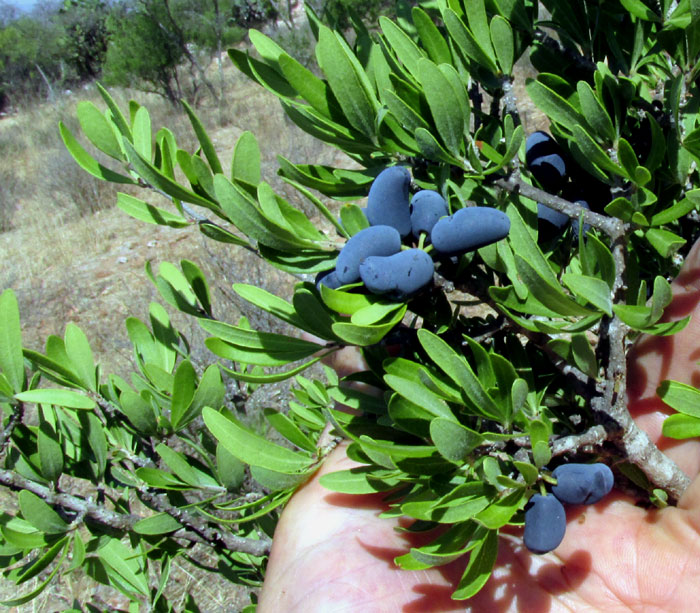
On rocky, grassy slopes around La Higuera, densely branching bushes about 4m tall (13ft) turned up bearing many juicy looking fruits, shown above. Though here the bushes were common, I'd not seen them around Tequisquiapan. But here the elevation is about 120m higher, and the thin soil gathers atop volcanic rock, mostly rhyolite, instead of the valley floor's hard-compacted sediment formed from run-off from these rocks, so maybe that explains its absence down below. The drupe-type fruits, about 10mm long (0.4inch) were curved like kidney beans, dark blue, and covered with a frosty bloom, or glaucescence, that came off when touched. The fruits were abundant and handsome on the dark green tree in an otherwise late-dry-season, gray/brown landscape. Below, you can see the single seed inside.
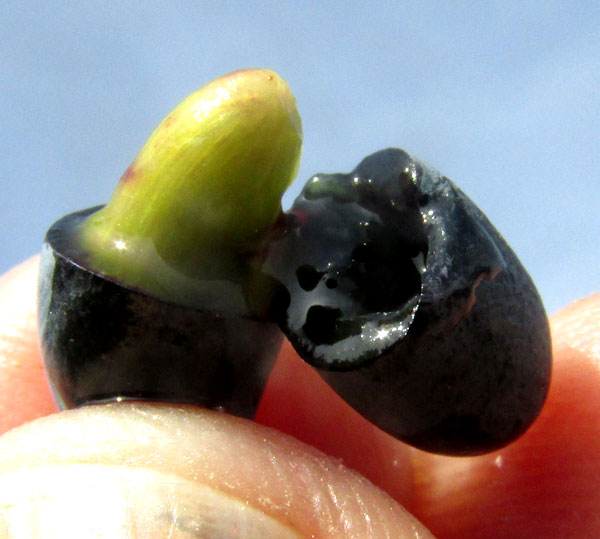
It looks good but tasted a little like pine resin mixed with something musky and bitter.
Having missed seeing the flowers, the bush's identity was unclear, though I thought that probably it was a member of the Buckthorn Family, the Rhamnaceae. Maybe with such distinctive fruits, and with details of leaves and stems, it could be figured out.
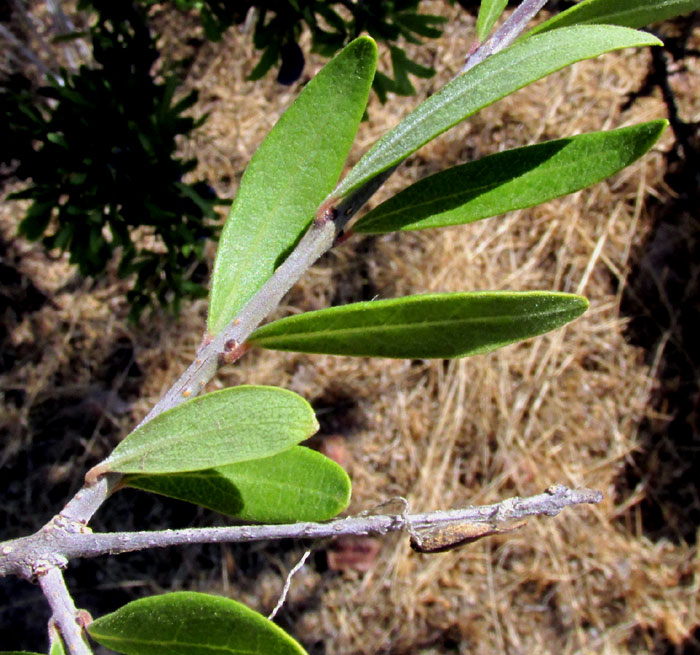
The stems, like certain members of the Buckthorn Family, halfheartedly formed weak, spine-like parts, as seen above, but there were no real spines or thorns. The leaves were typical of many bushes of arid land, their forms simple in a way aspiring to reach the golden mean between exposing enough surface area for adequate photosynthesis, and not exposing so much surface area that too much water is lost through evaporation. Also the leaves blushed with a slight silveriness, which protects the genetic information in the leaves' cell nuclei from too much damage from the day-long, very intense sunlight we get here. Much of the silveriness was caused to hairs, shown better below:
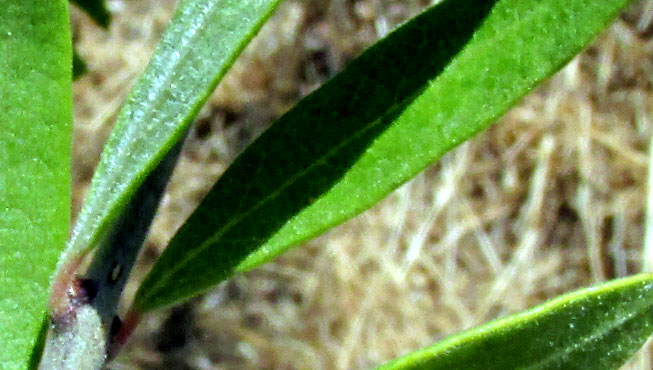
Finally, here's what the whole bush looked like, wide-spreading and low, like many woody species in semidesert or savanna environments:
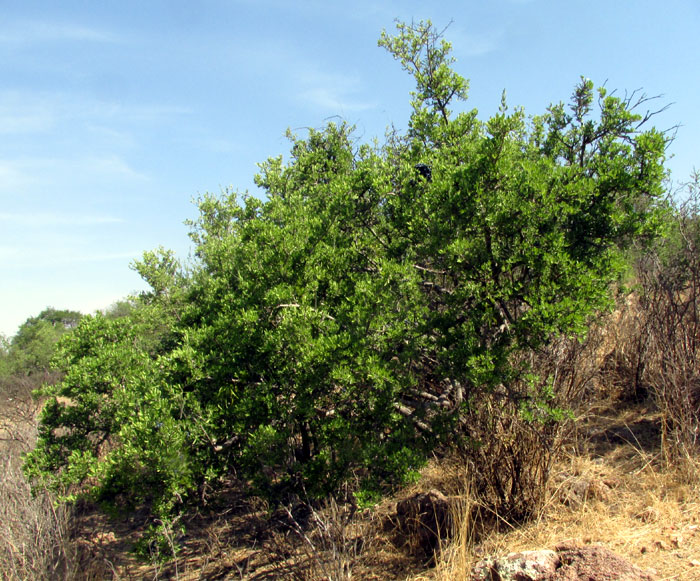
It was hard to figure this one out. In the end I looked at online herbarium specimens and pictures of plants on the Internet for every member of the Buckthorn Family this might occur in this area. Several species matched the leaves and stems, and came close to the fruits, especially in the genus Condalia, the snakewoods or bluewoods, but the Condalias produce spines, and the fruits are spherical.
Eventually, embarrassingly, it came down to going down a list of all the families of flowering plants with representatives in this area, from A to Z, hoping that being reminded of one of them might ring a bell. It happened upon reaching "O." "Oleaceae," the Olive Family. The fruits were like bent olives, and the European Olive tree's leaves and brittle, slender stems look very similar to these. The Flora del Bajío has its Olive-Family treatment completed, and we're in the Bajío region, so with the Flora it was easy to name our plant.
It's the Desert-Olive, FORESTIERA PHILLYREOIDES, which bears an English name because it occurs in semi-arid and subtropical parts of southern California to Arizona, south to Oaxaca in southern Mexico. It's described as abundant in arid scrub, grasslands, tropical deciduous forests, and occasionally in oak and pine forests and disturbed areas, at elevations from 1700-2400m (5600-7900ft).
We've run into Forestiera species before. In frequently flooded lowlands along the Mississippi River there was the Swamp-Privet, and on water-starved limestone ledges in southwestern Texas we had the Netleaf Forestiera. In generating its species, the genus Forestiera has displayed amazing adaptability to very differing environments.
In 2020 Víctor Manuel Martínez-Calderón and others published a work entitled "Propagación de Forestiera phillyreoides: una especie potencial para la restauración en el Centro-Norte de México," in which information for germinating the seeds of our bush was presented, in recognition of the fact that soil restoration must be attempted in this part of the world, and the Desert Olive is a good candidate for planting, to stabilize the soil.
That's exactly what's needed. And what a thing it'd be to see what now is a landscape ravaged by centuries of land over-use and forest clearing, populated with this bush's graceful, shade-producing, wide-spreading form.
entry from field notes dated January 17, 2023, taken on trail up the southeast-facing slope of Peña de Bernal on the northwestern side of Bernal, elevation ±2,220m (7280 ft); bedrock of intrusive, igneous dacite, similar to granite; Querétaro state, MÉXICO, (N20.748°, W99.949°)
DESERT OLIVE FLOWERING
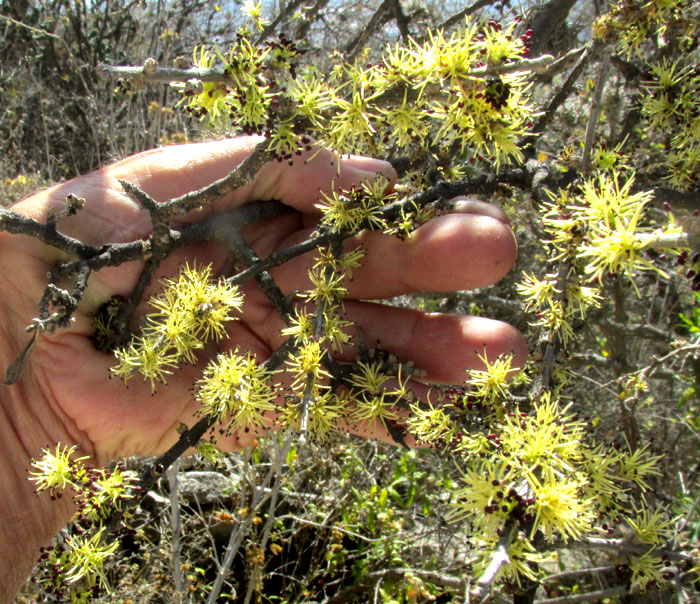
Beside the steep trail climbing toward Peña de Bernal's stone face, a small, gnarly tree mostly devoid of leaves and with side-branches often thorn-like bore the above flowers.
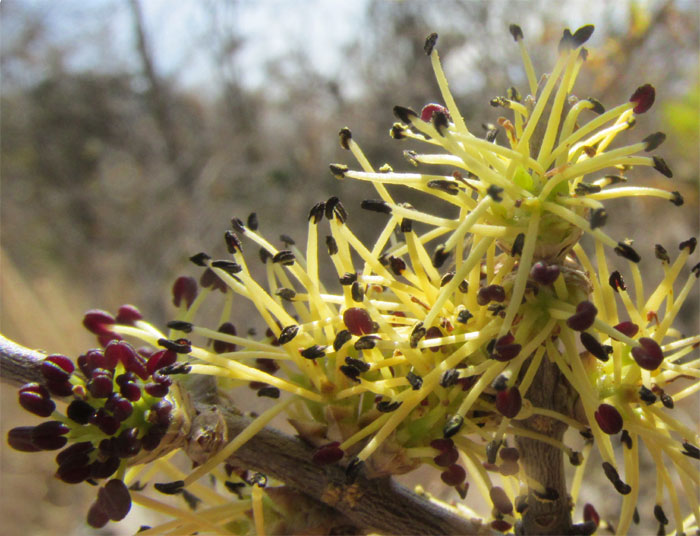
The flowers exhibited no calyx or corolla, and no female parts are visible; the many stamens with yellowish filaments and blackish anthers arose from bowl-shaped structures consisting of bud scales. Below it's easier to see how more immature flowers arose from their buds. Notice that certain branches, especially lower ones, bore leaves, apparently remaining from the previous season:
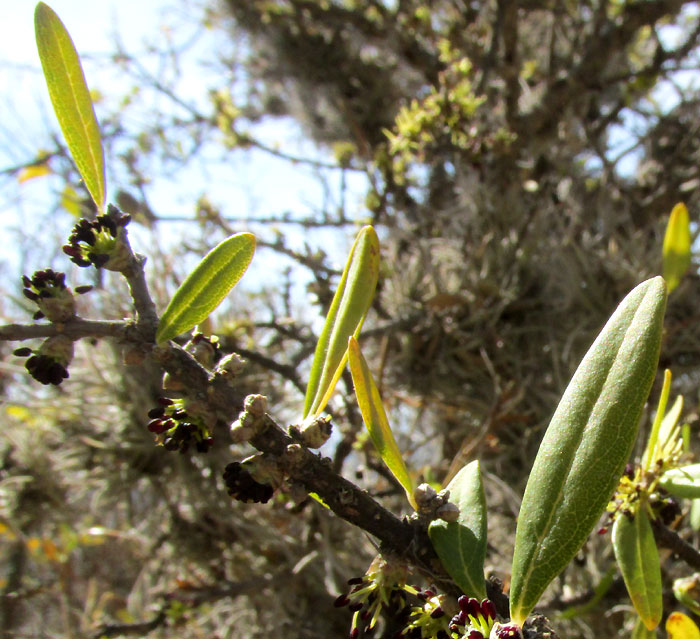

Up to this point, it's easy to be misled by some of what we've seen. First, it appears that only one leaf is produced at each stem node, though on lower branches it's clear that two leaves usually develop. Even more disorienting is that the flowers give the appearance of being unisexual male ones. However, the picture at the right shows a yellowish stigma emerging amid a mass of immature blackish anthers peeking from their cradle of hairy bud scales. However, even that is misleading.
For, this is the Desert-Olive, Forestiera phillyreoides, and forestiera flowers produce only 3-5 stamens. In the above pictures showing many stamens per flower bud, then, there must be more than one flower per bud. In fact, Forestiera phillyreoides flowers, the Flora del Bajío tells us, produce no calyx or corolla, or sometimes there are diminutive sepals, which would be hidden below the stamens.
Here's what our tree looked like on the steep southeastern slope of Peña de Bernal:

The gray masses within the trees are Ballmosses, which are bromeliads.